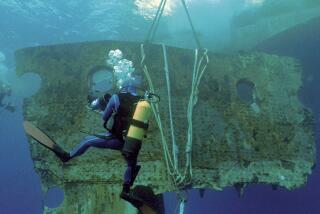11-Year-Old Inspires Searchers
- Share via
ABOARD THE RUDE OFF LONG ISLAND — In a picture taped to a blue metal case that houses sophisticated navigational equipment on this ship, 11-year-old Larkyn Lynn Dwyer smiles broadly, her dimples deep and her bangs hanging almost into her eyes.
“This is what we’re here for, guys,” Cmdr. Sam De Bow, skipper of this 90-foot hydrographic survey ship, told his crew Tuesday as he posted the picture on the case that houses the vessel’s global positioning system, which can pinpoint its location within a few feet on a featureless sea.
As the ship plows the Atlantic waters in the recovery zone where TWA Flight 800 crashed in flames last Wednesday, Larkyn Lynn, who was aboard the airplane bound for Paris, has come to personify the 230 victims for the vessel’s 11-member crew.
“I have a daughter that age. That’s what really hit home for us,” said De Bow.
Wallowing in rain-pocked seas darkened by a sunless sky into the gun-barrel gray of a plain metal coffin, the Rude (pronounced “rudy”), spent Tuesday as it has each of the previous three days and nights, towing its 4-foot, yellow, torpedo-shaped sonar as it searches for the sunken remnants of the TWA jetliner.
The 30-year-old Rude uses three sonar-based systems to map the ocean bottom for the National Oceanic and Atmospheric Administration, an agency of the U.S. Department of Commerce. Glacial rocks, canyons, 400-year-old shipwrecks slowly dragged to and fro by undersea currents--the work of the ages are the world of the Rude. And so are hidden sandbars deposited by winter nor’easters and growing ever riskier to shipping. These are the usual targets of the Rude’s sonar.
But the vessel--by fate and by mission--has played a central role in retrieving bodies and pieces of the Boeing 747 jetliner. By chance, it happened to have been nearby when the plane went down.
“We went through right here at 2 o’clock in the afternoon the day of the accident,” De Bow said, standing under a dripping canopy just off the bridge as he looked toward the crash site to the south past white caps and troughs of a 5-foot sea.
The ship had just completed a mission mapping a segment of the New York harbor and was on its way to Point Judith, R.I., where it was to refuel, pick up stores and rotate crew members. The crash occurred at 8:48 p.m. EDT and by 10:30 p.m. the Rude had turned around and returned to the area, reaching the crash site at 7:10 a.m. Thursday. It was the second federal vessel, after a Coast Guard unit, to arrive on the scene.
On Thursday, its crew--nostrils stung by the odor of jet fuel that lingered that morning--towed a 35-foot section of wing, too heavy for its on-board crane, to the U.S. Coast Guard Cutter Jupiter. To their personal, if not professional, relief, the crewmen found no bodies.
But they pulled from the water pieces of the downed airliner more manageable than the wing segment and they retrieved personal belongings of its passengers.
“When we recovered a wallet with a driver’s license of a young girl from California, it put it into perspective for us,” said Charles Neeley, 28, a survey technician.
Forced back to port after Friday by gale-force winds and pitching seas--and running low on fuel, water and food because it had not received its scheduled replenishments, it was off-station until early Sunday.
On Monday morning, Neeley was reading the sonar returns--sound waves that bounce off the ocean floor and the objects resting there--when the ship found a major debris field, the only such submerged wreckage discovered to date. Indeed, using projections of the airplane’s estimated trajectory, it scanned three likely areas and found the debris field in one.
The information was given to the Navy, which sent divers down to retrieve six bodies Monday that had been trapped under a piece of fuselage.
“I was waiting to see that target scroll across the screen. It was very exciting to see it up,” said Lt. j.g. Nathan Hill, the ship’s second in command.
Immediately word spread throughout the ship, from the bridge to the galley three decks below, from the bow to the fantail and, most important, to Navy divers: “There is it. Look at this. We’ve got something now.”
More to Read
Sign up for Essential California
The most important California stories and recommendations in your inbox every morning.
You may occasionally receive promotional content from the Los Angeles Times.












